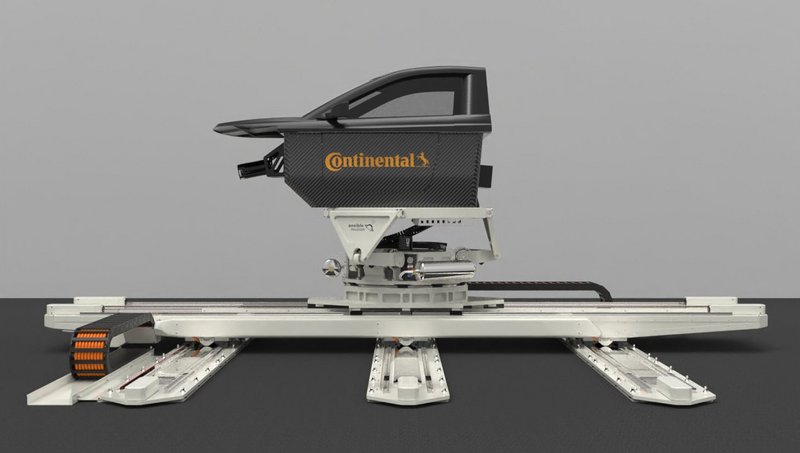Technological Excellence in Tire Development: Continental Is Celebrating Its 150th Anniversary
- Milestones include the respective first tire with tread, removable rim, first tubeless tire, winter tire or pneumatic tractor tire
- In addition to premium tires, Continental today offers smart, digital tire solutions and services
- By 2050 at the latest, all Continental tires will be manufactured from 100 percent sustainable materials and the supply chain will be completely climate-neutral
Hanover, Germany, July 20, 2021. On October 8, 2021, Continental will celebrate its 150th company anniversary. Since its foundation in Hanover, Germany in 1871, Continental has been developing pioneering technologies and services for sustainable and connected mobility of people and their goods. From a small factory in Hanover the company has developed into one of the global players in the automotive industry, which is now operating in 58 countries and markets. Continental is the oldest independent and also one of the largest tire manufacturers in the world. Over the past 150 years, the company has set standards in the tire industry with its pioneering spirit and innovative strength. Time and again, it was Continental’s engineers who, with their ground-breaking inventions, ensured that tires became safer, more efficient, and sustainable. Milestones in Continental’s tire development include the first treaded tire, the first tire with a detachable rim, the patent for the world’s first tubeless tire and, with its “all-terrain” model, the first dedicated winter tire. Likewise, the first pneumatic tractor tire came from Continental. Later came the first rolling resistance-optimized tire and the first production tire to feature a tread made of dandelion rubber. Continental is also one of the pioneers in the field of digitalization. As early as 1999 the tire manufacturer demonstrated that the data required for advanced driver assistance systems can be determined even more accurately and quickly if the tire is used as a data source. This was the birth of the intelligent tire. Meanwhile Continental is connecting its tires and their sensors to the cloud and offering its customers completely new, smart and digital tire solutions and services.
“Tires are our passion. Our technological excellence has ensured safety, reliability, and sustainability for 150 years. We are proud of this,” said Christian Kötz, Head of the Tires business area and member of the executive board of Continental. He added: “Many of today’s technology standards in tires come from Continental. Time and time again, we push the boundaries of what is possible. Our goal is to produce our entire product portfolio exclusively from sustainable materials in a climate-neutral way by 2050 at the latest.”
Continental’s roots go back to the early days of the founding era. On October 8th, 1871, the “Continental-Caoutchouc- & Gutta-Percha-Compagnie” was incorporated. The product range initially included a variety of rubber products, such as toy balls, rubber mats, roller coverings, rubberized fabrics or balloons and solid tires for carriages and bicycles. When the bicycle began its worldwide career in 1892 with freewheel and coaster brake, Continental was the first German company to produce pneumatic bicycle tires and hence “pneumatics” soon became a household word. A short time later, in 1898, the production of pneumatic tires for cars also began. The first pneumatics were still treadless and had comparatively limited handling characteristics by today’s standards, especially on wet or wintry roads. All tire manufacturers were looking for solutions to the sliding susceptibility of their products – until Continental presented the world’s first car tire with a tread in 1904.
Industrialization and mobility needs as early drivers of innovation
The triumph of individual mobility and advancing industrialization demanded tire products for ever new fields of application. In addition to safety, the theme of comfort also increasingly became the focus of attention. In 1908 Continental engineers caused a worldwide sensation with the invention of the detachable rim, which made wheel and tire mounting much easier. To mark its 50th anniversary, Continental was the first German company to launch large tires for commercial vehicles on the market. In 1928 tires for agricultural tractors and tractor units were manufactured for the first time. The T2 agricultural tractor tire was the first pneumatic agricultural tire in Europe. In the industrial sector, Continental revolutionized the segment of solid tires, which are used on forklift trucks, airport vehicles and other heavy-duty industrial applications. Introduced in 1932, the great success of the ContiSuperElastic solid rubber tire led to the abbreviation for this category that is customary in the industry today: CSE.
Another milestone in the industrial history of the 20th century is the first tire made of synthetic rubber, which rolled out of Continental’s factory hall in 1936. Under the effects of the shortage economy during the war years, the tire manufacturer launched the first research series to obtain rubber from Russian dandelions. A project that was taken up again in 2011 and has been successfully driven forward since then. The “Urban Taraxagum” bicycle tire is Continental’s first tire made in series production using rubber from dandelions.
In 1943 Continental filed a patent application for the tubeless tire. An invention that significantly improved the rolling resistance of tires and became a common technological principle in the post-war period and still is today. Continental first enabled particularly safe driving in winter in 1934 with its “all-terrain” model, its first dedicated tire designed for snow and thus its first winter tire. In 1953 Continental crossed the snowy St. Gotthard Pass in Switzerland with its M+S tires (mud and snow) under notarial supervision, successfully completing the first winter tire test in history.
Intensive testing enables safety – in city traffic or when driving under extreme conditions
Before a new tire from Continental is launched on the market, it has to successfully pass a wide range of tests, be it technical innovations in the passenger car, truck or special tire sector. In total, new tire models cover 25 million test kilometers each year before the actual start of production. The enormous effort is justified. Because it is the foundation for the product quality of the tire manufacturer from Hanover, for all applications – even under extreme conditions. In 2003 Continental became the only supplier of a production tire with a permissible maximum speed of up to 360 km/h with the ContiSportContact Vmax. In 2007 the ContiSportContact Vmax was the first tire to be entered in the Guinness Book of Records and was the first choice for numerous record-breaking races of well-known tuners.
For the testing of tires and all conceivable conditions, the company maintains state-of-the-art tire testing facilities worldwide. The Contidrom near Hanover, the “prototype” and reference of all Continental tire test centers, was opened in 1967. As early as 1968 the first electronically controlled driverless car took to the track at the Contidrom, to the astonishment of the press and public. Continental has further developed this technology and now uses it at its test site in Uvalde, Texas, USA, to subject its tires to endurance tests.
In 2012 the Automated Indoor Braking Analyser (AIBA) was officially opened at the Contidrom test site. This facility, which is the only one of its kind in the world, enables the brake performance of tires on different road surfaces to be tested all year round, regardless of the weather and fully automatically using unmanned vehicles. In the future, tires will also be tested there in a new type of dynamic driving simulator. Thus, professional test drivers will also be carrying out realistic driving scenarios virtually. Having each test cycle completed in the driving simulator instead of on real roadways means fewer test tires need to be produced. Hence, this investment in the new testing technology also contributes to Continental’s extensive sustainability efforts.
Resource awareness as an early driver of technological excellence
Continental has been committed to greater sustainability in the tire and automotive industry since the early seventies of the last century. The effects of the oil crisis in 1973 provided the impetus for a research project to develop tires with optimized rolling resistance. The insights gained in this project ultimately led to the presentation of a previously unprecedented product in 1993. For the first time, a tire in the ContiEcoContact combined environmental benefits and economic aspects with outstanding driving and safety characteristics. Since then Continental has been facing the major challenges in dealing with finite raw materials and the need to reduce CO2 emissions. For many years now sustainable and responsible management has been an integral part of Continental’s corporate strategy. Efforts here are centered around the strategic topics of climate action, low-emission mobility, the circular economy, and sustainable supply chains, thus embracing all phases of the value chain. As early as in 1903, a branch plant was set up in Seelze near Hanover for the reprocessing and recycling of rubber scrap. In 2013, Continental opened its unique ContiLifeCycle plant in Hanover Stöcken. With its integrated approach to retreading for truck and bus tires and a specially developed industrial-scale rubber recycling plant, it is an industry pioneer.
In order to make the tires of the future even more energy-efficient and environmentally friendly in terms of production, use and recyclability, the company is systematically investing in the research and development of new technologies, alternative materials, and environmentally compatible production processes. For example, the tire manufacturer intends to gradually switch to 100 percent sustainably produced materials in its tire products by 2050.
Sensor technology and digitalization enable innovative tire solutions and services
Continental is also one of the pioneers when it comes to the digitalization of tires. As early as in 1999, the tire manufacturer demonstrated that the data required for advanced driver assistance systems could be determined even more accurately and quickly by using the tire as a data source. That was the birth of the intelligent tire. Since then Continental has continued to drive forward the digitalization of tires, enabling completely new services for fleet and end customers. Since 2010 Continental has bundled all services for fleet customers under the umbrella of its brand Conti360° Fleet Services. From the recommendation and perfect selection of the right tires to correct mounting and quick assistance in the event of a flat tire to constant inspection and comprehensive tire reports for all their vehicles, the fleet operators receive a highly professional all-round tire service.
The company is continuing to expand the ecosystem of smart, digital solutions for Continental’s premium tires that has been created in the meantime. As one of the world’s largest suppliers of electronics, sensor systems and software in the mobility industry, Continental has a decisive competitive advantage here. For example, Continental’s ability to allow the tire to communicate with other safety-related components as a central element in the vehicle system led to a ground-breaking project back at the beginning of the millennium: the 30-meter car. The coordination of all systems involved in the braking operation resulted in a vehicle that came to a standstill after only 30 meters with full braking at 100 km/h. At that time the average braking distance was still between 36 and 40 meters. This corresponded to shortening the braking distance by up to 25 percent.
Today, Continental is using the direct connection of its tires and sensors to the cloud to offer completely new business models. Fed by a large number of data points, Continental's fleet customers can check the condition of their tires at any time using algorithms developed in-house. This means that tire maintenance can be carried out on an as-needed basis, not as a preventive measure, and thus much more efficiently. Fleet providers thus benefit from minimized downtime due to repairs, increased safety, lower overall costs due to greater energy efficiency, and generally more efficient operation. In 2020, Continental set new standards with the presentation of its successful pilot project for significantly accurate tread depth monitoring using algorithms and vehicle telemetry data.
In the future Continental will continue to stand for innovative excellence in tire technology with its premium portfolio in the passenger car, truck, and special tire segments. In its new strategy program presented in 2020, Continental describes its path into the new decade. The focus of the Vision 2030 strategy program is the consistently customer-centric orientation of the organization and all business activities. In addition, the tire sector aims to continue to grow profitably and differentiate itself from its competitors in a rapidly changing market environment in the areas of sustainability and digital solutions.

Henry Schniewind
Head of External Communications
Continental Tires

Silke Bernhardt
Head of Communications & Public Affairs
Continental Tires




















